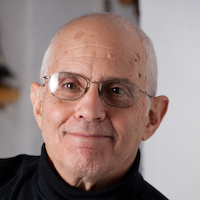Darshan at a Distance.
In researching American Veda, my attention was occupied mainly by the long parade of gurus, swamis and yoga masters who came here. But one of the most exhilarating discoveries was the enormous impact of great ones who never set foot in America and still enlighten and inspire decades after their passing.
This article is a tribute to them.
Two names are familiar to modern yogins because the disciples they sent to the West had an enormous impact. Swami Sivananda (1887-1963) gave up a lucrative medical practice at age 36 to become a monk. He turned a cowshed into the Divine Life Society ashram, which became the cornerstone of the holy city of Rishikesh and a destination for pilgrims from all over the world. But he is best known in the West because of the success of his disciples, principally Swami Vishnudevananda (1927-1993) and Swami Satchidananda (1914-2002). The former founded the Sivananda Yoga Vedanta Centers and published the bestselling The Complete Illustrated Book of Yoga (1960); the latter started the Integral Yoga Institute and famously delivered the opening address at the 1969 Woodstock Festival. Together, the gurubhais can share credit for creating the first systematic programs for training American yoga teachers.
The other progenitor of today’s yoga scene was Tirumalai Krishnamacharya (1888-1989), who cemented the foundation of what came to be called modern postural yoga. In a dramatic break from tradition, he anointed a European woman, Indra Devi, to teach in the West. Later, of course, came K. Patthabi Jois and B.K.S. Iyengar, and it is a rare yoga class these days that does not bear at least a fingerprint of those two masters. Krishnamacharya’s son, T.K.V. Desikachar, continues the family legacy at his institute in Chennai.
Sivananda and Krishnamacharya dispatched ambassadors to the West. More intriguing to me is the huge influence of three gurus who sent no one anywhere to do anything. Two of them passed away more than six decades ago, the other nearly four.
The luminous face of Ramana Maharshi (1879-1950) adorns far more home altars and bookshelves now than ever in his lifetime. Only those who read Paul Brunton’s mid-1930s classics, A Search in Secret India and The Secret Path, knew of him before World War II. In 1949, he was the subject of a 12-page Life magazine spread with exquisite photos and a surprisingly knowledgeable text. And he was the model for the guru character in Somerset Maugham’s famous novel, The Razor’s Edge. But now he is the face of Advaita Vedanta and generic nonduality, thanks in large part to American teachers who were inspired directly by Ramana or who spent time with either of the two modern exemplars of nondualism, H.W.L. Poonja (1913-1997) and Nisargadatta Maharaj (1897-1981).
Ramana’s contemporary, Sri Aurobindo (1872-1950) was equally sainted in India during his lifetime. Jailed by the British for his pro-independence activism, he had a spiritual awakening that led to the establishment of an ashram in Pondicherry that remains active to this day. The chain of colorful people and events that emanated from his work is worthy of a novel. The links include Frederic Spiegelberg, an important scholar of religion; Michael Murphy, whose vision of an East-West meeting ground for the exploration of human potential gave us the Esalen Institute; Haridas Chaudhuri, an India-born philosopher who created the still-functioning Cultural Integration Fellowship in San Francisco; the American Academy of Asian Studies, whose faculty—led by Alan Watts, the hugely popular interpreter of Eastern spirituality—mentored Beat poets and early yoga figures like Richard Hittleman and Rama Jyoti Vernon. The academy evolved into the California Institute of Integral Studies, which is now churns out scholars and psychotherapist informed by both East and West. Sri Aurobindo’s prodigious writings have influenced Western thinkers from Science of Mind founder Ernest Holmes to Ken Wilber.
Finally, Neem Karoli Baba, the legendary guru who turned psychologist Richard Alpert into spiritual teacher Ram Dass. That alone would have sealed his place in history. But dozens of young seekers followed the author of Be Here Now to India, and a stunning percentage of them honored Neem Karoli’s injunction to “love, serve, remember” in noteworthy ways. To name just a few: kirtan wallahs Jai Uttal and Krishna Das learned their art at the guru’s feet; psychologist Daniel Goleman went on to write bestsellers such as Emotional Intelligence; and physician Larry Brilliant became a leader of global public health campaigns after the guru asked him to rid India of smallpox. Amazingly, there are Neem Karoli devotees today who were born long after the master passed from the planet.
The Tibetans say that gurus are like fire: stand too far away and you don’t get warm; get too close and you can get burned. The legacy of these masters shows that the fire of awakened consciousness is not constrained by time or space.
Phil Goldberg’s East Coast Speaking Schedule:
– Friday, March 25, 5:00, Emerson Hall, Harvard, lecture for “Dharma,” the Hindu Students’ Association
– Sat. March 26, 2-5 pm, workshop at Arlington Center, Arlington, MA, http://www.arlingtoncenter.org/events.html
– Sun. March 27, 7pm, lecture/signing at Down Under Yoga, Newtonville MA, http://www.downunderyoga.com
– Wed. March 30, 6:30 – 9:30, workshop at Sadhana Meditation Center, Portland Maine, http://www.sadhaname.com.
– Sat. April 2, 2:30-4:30, workshop at Integral Yoga Institute, New York, http://www.iyiny.org/
– Wed. April 6, 6:30, Livingston NJ Public Library, http://livingston.bccls.org/
– Fri. April 8, 7:00, One Spirit Learning Alliance in NY City. http://www.onespiritinterfaith.org/
– Sat. April 9, 4:00, Hindu Temple Society of North America, Queens NY, http://www.nyganeshtemple.org/home.aspx
– Sun. April 10, 2:00, Sri Aurobindo Center, Morganville, NJ, http://www.sayfna.org
Previous Phil Goldberg articles:
True or False? Physical Yoga Has Influenced America More than Spiritual Yoga.
How Yoga Has Transformed American Spirituality:
An Interview with Phil Goldberg, “American Veda”.

 Share on bsky
Share on bsky




Read 9 comments and reply